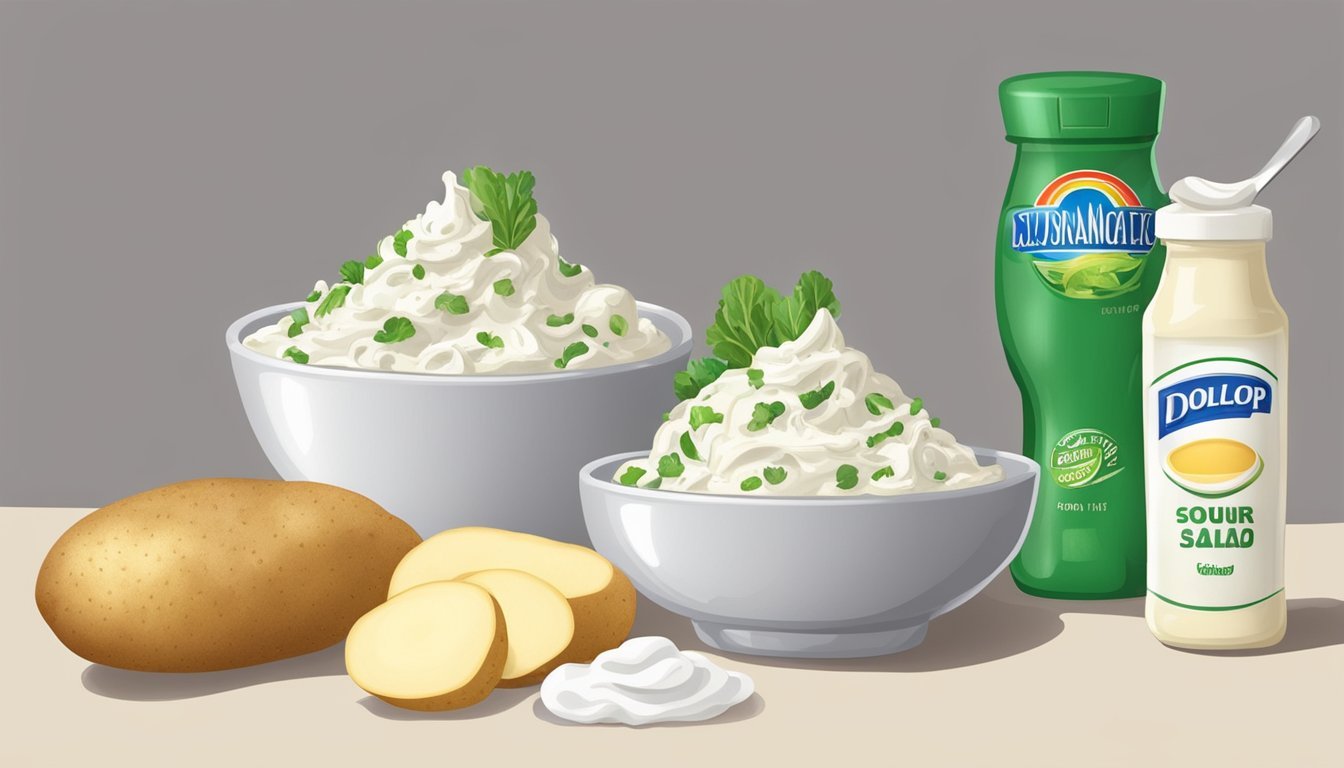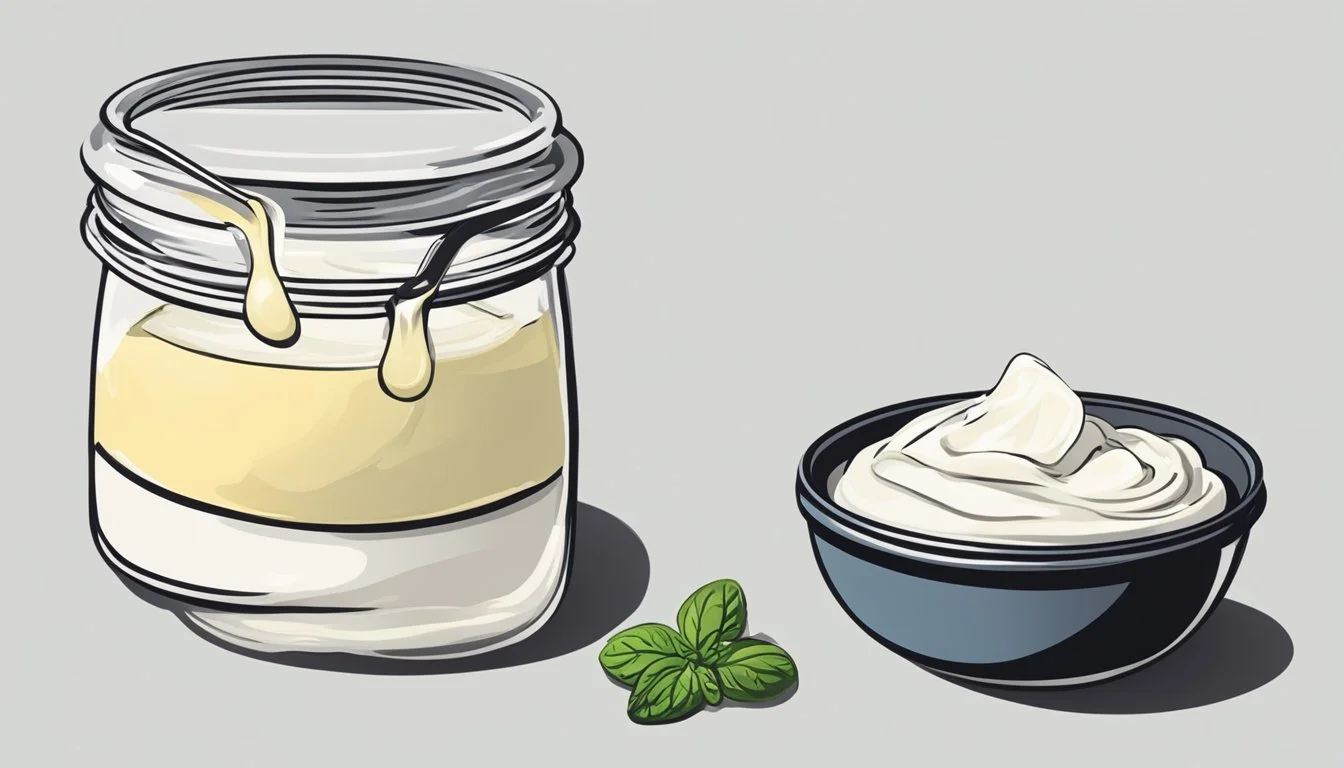How to Substitute Sour Cream for Mayonnaise
A Simple Guide for Creamier Dressings
Sour cream (how long does cream last?) and mayonnaise are both staples in the culinary world, commonly found in a variety of recipes ranging from dressings to sandwiches (What wine goes well with sandwiches?). They are favored for their creamy texture and ability to enhance the flavors of dishes. However, when mayonnaise isn't available or when a lighter alternative is desired, sour cream serves as an excellent substitute due to its similar texture and tanginess. It is particularly useful for individuals looking to adjust the fat content of their meals without sacrificing the consistency that mayonnaise typically provides.
Utilizing sour cream as a replacement for mayonnaise can be a straightforward swap in many recipes. While mayonnaise is traditionally made with oil and egg yolks, giving it a rich and stable emulsion ideal for creamy dressings and moist cake preparations, sour cream, which is cultured cream, offers a similar consistency with a slightly tangy profile. This makes it a versatile ingredient in the kitchen, capable of performing many of the same functions as mayonnaise, albeit with a distinct flavor twist that can complement a variety of dishes.
Understanding the Basics
When considering a substitution in the kitchen, it is essential to compare the characteristics of sour cream and mayonnaise, such as taste, texture, and fat content. Understanding these aspects will ensure that the substitute maintains the integrity of the dish.
Comparing Sour Cream and Mayonnaise
Taste: Mayonnaise has a neutral flavor profile with a balance of richness from oil and egg yolk; whereas, sour cream offers a tangy taste due to the lactic acid from fermentation.
Texture: Both mayonnaise and sour cream have creamy textures, although mayonnaise tends to be smoother due to its emulsification process, while sour cream has a slightly thicker consistency.
Ingredients: The primary components of mayonnaise are oil, egg yolk, and sometimes vinegar or lemon juice, contributing to its creamy consistency. Sour cream, in contrast, is made from cream that has been fermented by lactic acid bacteria.
Fat Content: Mayonnaise generally contains more fat, since oil is a main ingredient, whereas sour cream has a lower fat content due to its cream base.
Benefits of Substituting Sour Cream
Substituting sour cream for mayonnaise can offer a reduction in fat content and add a distinctive tanginess to dishes. It can be particularly beneficial in recipes where a lighter consistency is desired or when a tangy flavor can enhance the dish. Additionally, sour cream can serve as a source of nutrients like vitamins A, riboflavin, and B12.
Practical Substitution Techniques
When substituting sour cream for mayonnaise, one must consider both texture and flavor. The right approach will maintain the consistency of the dish and complement its taste profile appropriately.
Adjusting for Consistency
To achieve the thick consistency similar to mayonnaise, one can directly use full-fat sour cream. If the sour cream is too thin, it can be thickened by adding a small amount of cream cheese (how long does cream cheese last?). Conversely, if the mixture is too thick, thinning it with a bit of milk can help reach the desired consistency.
Thicken with cream cheese: For every cup of sour cream, blend in 1-2 tablespoons of cream cheese until well incorporated.
Thin with milk: Start by adding milk, one tablespoon at a time, stirring consistently until the consistency matches that of mayonnaise.
Balancing the Flavors
Sour cream has a milder tartness compared to mayonnaise, which is balanced with acidic elements like vinegar or lemon juice. Adding these ingredients gradually and tasting frequently helps to reach the desired flavor profile.
Acidic balance: Combine 3/4 cup sour cream with 1 tablespoon lemon juice or vinegar.
Seasonings: Incorporate salt, garlic, herbs, or pepper to taste. For tanginess, a dash of mustard can be effective.
Example Blend:
3/4 cup sour cream
1 tablespoon lemon juice or vinegar
1/4 teaspoon salt
Ground pepper to taste
1/2 teaspoon mustard (optional)
Gradually mix these ingredients, adjusting the quantities as needed for the specific dish one is preparing.
Application in Recipes
When substituting sour cream for mayonnaise in recipes, it is essential to consider the dish's flavor profile and desired consistency. Sour cream can offer a tangier and creamier texture to a variety of recipes.
Dressings and Sauces
For dressings and sauces where mayonnaise is typically used, such as tahini sauce, tzatziki, or aioli, sour cream can be a direct substitute. To adjust for sour cream's tangier taste, a cook might add an extra pinch of sugar or another sweetener to balance the flavors. This substitute is particularly effective in salad dressings where sour cream's thicker consistency provides a rich, luxurious mouthfeel. Ingredients like vinegar or mustard can be tweaked to ensure a well-rounded taste.
Baking Considerations
In baking, sour cream's acidity can activate baking soda, adding leavening power that mayonnaise lacks. This can result in baked goods with a lighter texture. The fat content in sour cream is comparable to mayonnaise, allowing it to contribute to the moistness and richness of the baked item. However, one should note that sour cream's distinctive tang might alter the final flavor of the baked product, so it's best used in recipes where a slight tangy note is acceptable.
Cold Salads and Sandwiches
For cold dishes like potato salad or egg salad, the use of sour cream as a mayo substitute can lead to a similar consistency while introducing a slightly different, more pronounced taste. Adjusting the seasoning with salt, pepper, or herbs can create a balanced flavor profile. In sandwiches, a blend of sour cream with a neutral-flavored thickener like Greek yogurt or hummus could provide the desired creaminess without overpowering the sandwich's primary ingredients.
Healthy and Dietary Alternatives
When substituting sour cream for mayonnaise, one must consider both health impacts and dietary restrictions. The following alternatives cater to those seeking lower fat options or vegan and dairy-free substitutions.
Low-Fat and Nonfat Options
For a healthier twist on traditional sour cream, low-fat and nonfat versions provide similar textures and flavors with fewer calories. Low-fat sour cream options typically contain about 40% less fat than their full-fat counterparts, while nonfat versions eliminate fat content altogether.
Low-Fat Sour Cream: A substitute that decreases fat content without sacrificing creaminess.
Nonfat Greek Yogurt: Offers a tartness and thickness akin to mayonnaise, while being high in protein and low in calories.
Vegan and Dairy-Free Substitutions
Those with dairy restrictions or following a vegan diet can rely on plant-based alternatives that replicate the richness of mayonnaise without animal products.
Vegan Mayo: Commercially available vegan mayonnaise often uses modified food starch and pea protein to achieve a similar consistency to traditional mayo.
Dairy-Free Options:
Coconut Cream: Thick and rich, suitable for adding to sauces and dressings.
Cashew Cream: Blended cashews create a smooth base, ideal for a variety of spreads.
Tahini Sauce: Made from sesame seeds, tahini has a unique flavor that works well in savory dishes.
Nut Butter: While more unorthodox, certain nut butters can offer a creamy texture and are more suitable for sweet dishes.
Making Homemade Substitutes
Preparing homemade sour cream and mayonnaise allows for customization and ensures fresh, preservative-free alternatives. It's a straightforward process involving common kitchen ingredients and utensils.
Creating Your Own Sour Cream
One can create sour cream using the fermentation process with buttermilk and heavy cream. To start, they simply combine one cup of heavy cream with one tablespoon of buttermilk. This mixture should be left at room temperature for 24 hours to allow the fermentation to take place, which thickens the cream and gives it the characteristic tanginess of sour cream. After the fermentation period, it's important to chill the sour cream to further thicken it and enhance its flavor.
Crafting Alternative Mayo
Homemade mayo requires few ingredients: an egg, oil (such as canola or vegetable), lemon juice or apple cider vinegar, and mustard or Dijon mustard which acts as stabilizers. First, one must blend the egg with the acid—lemon juice or vinegar. The crucial step is to beat the oil into the egg mixture slowly, usually a drop at a time, to start the emulsion process. After the mixture begins to thicken, they can add the oil in a steady, thin stream until the mayo reaches the desired consistency. For flavor, they can add a pinch of salt and a teaspoon of mustard. The mayo should be chilled before use to improve its texture and flavor.
Nutritional Considerations
When substituting sour cream for mayonnaise, one should consider the nutritional differences between these two condiments to make an informed choice that aligns with dietary needs and preferences.
Calories: On average, one tablespoon of sour cream contains about 59 calories whereas the same amount of mayonnaise has approximately 94 calories. This makes sour cream a lower-calorie alternative for those managing their calorie intake.
Protein: Sour cream provides 1 gram of protein per serving, which is a marginal amount but can contribute to the daily protein needs. Mayonnaise, on the other hand, has a negligible protein content.
Calcium: Dairy products like sour cream contain calcium, which is vital for bone health. Substituting mayonnaise with sour cream can add a small amount of calcium to one's diet.
Saturated Fat: Both condiments contain saturated fats, with mayonnaise typically having a higher amount. Reducing saturated fat intake is often recommended for heart health, thus sour cream might be considered a better choice in this regard.
Healthy Fats: Mayonnaise is made with oils that can provide healthy fats, such as omega-3 fatty acids, dependent on the type of oil used. However, it is still high in total fat content. Sour cream contains less fat per serving, but the types of fats are not as diversified.
In summary, sour cream can offer a lower-calorie, lower-fat alternative to mayonnaise with the addition of some beneficial nutrients, such as calcium. Each individual should consider their own nutritional needs and consult with a healthcare provider if they have specific dietary concerns.
Additional Tips and Tricks
When substituting sour cream for mayonnaise, one should consider the taste and texture differences to ensure the final product retains its desired qualities. Mayonnaise offers a creamy texture and a more neutral flavor, which makes it an excellent spread for sandwiches and base for dressings.
For Dips: To replicate the tangy taste of mayonnaise in dips using sour cream, one might add a teaspoon of lemon juice or vinegar per cup of sour cream. This adjustment helps maintain the expected flavor profile.
For Creamy Consistency: If one finds the sour cream too thick compared to mayonnaise, thinning it with a small amount of milk can improve spreadability without significantly altering taste.
Texture Concerns: For applications where mayonnaise provides a specific texture, such as in baked goods or salads, consider the moisture content. Sour cream has a higher fat content, which can change the outcome of recipes like cakes or dressings.
Below is a table to help with common substitutions:
Use Case Mayonnaise Sour Cream Adjustments Needed Sandwiches 1 tbsp 1 tbsp Add a pinch of salt if desired Salad Dressing 1 cup 1 cup Add 1 tbsp lemon juice to mimic tanginess Baking 1 cup 1 cup Reduce liquid in recipe or add more flour
Remember, substitutions may alter the end result slightly. It's always best to test a small batch when trying these adjustments for the first time.






